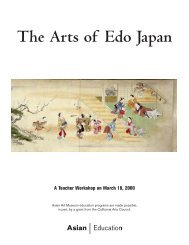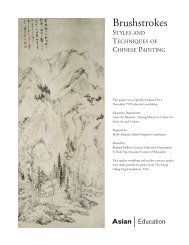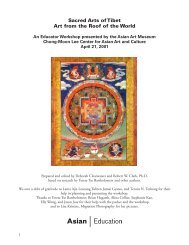- Page 1 and 2: China: The Glorious Tang and Song D
- Page 3 and 4: Table of Contents 3 An Introduction
- Page 5 and 6: An Introduction to the Tang and Son
- Page 7 and 8: of life. Most of its ideas and prac
- Page 9 and 10: Tang and Song Religion and Philosop
- Page 11 and 12: Enlightenment is not a tree to begi
- Page 13 and 14: trines freely throughout the empire
- Page 15: ZHU XI (1130-1200) The intellectual
- Page 19 and 20: ureaucrat; he loved wine and travel
- Page 21 and 22: career and eventually retired to pu
- Page 23 and 24: Children Children don’t know what
- Page 25 and 26: But my mind is clearer than the riv
- Page 27 and 28: Science in the Tang and Song Dynast
- Page 29 and 30: Above: Ming dynasty armillary spher
- Page 31 and 32: PRINTING Among the most globally si
- Page 33 and 34: types of kilns: Ding Kiln, Ru Kiln,
- Page 35 and 36: BIBLIOGRAPHY [1]. Joseph Needham,
- Page 37 and 38: PERSONAL CONNECTIONS Confucianism T
- Page 39 and 40: The role of the teacher in Chinese
- Page 41 and 42: PERSONAL CONNECTIONS Floating on Cl
- Page 43 and 44: advances in his learning and spirit
- Page 45 and 46: enough, everyone in the class assum
- Page 47 and 48: Introduction to the Arts of the Tan
- Page 49 and 50: ased on court styles or through ind
- Page 51 and 52: mented the use of hammered metal cu
- Page 53 and 54: • Sancai: Literally “three colo
- Page 55 and 56: Despite these persecutions and cont
- Page 57 and 58: The importance of calligraphy is un
- Page 59 and 60: ate, and painted in colorful washes
- Page 61 and 62: CHARACTER STROKES All Chinese chara
- Page 63 and 64: Mantou (northern) Kiln Long (southe
- Page 65 and 66: SLIDE 1A SLIDE 1B Camel, approx. 69
- Page 67 and 68:
SLIDE 2A SLIDE 2B Dancer, probably
- Page 69 and 70:
SLIDE 3A SLIDE 3B Plate in the shap
- Page 71 and 72:
SLIDES 4A SLIDES 4B Pair of tomb gu
- Page 73 and 74:
SLIDE 5A SLIDE 5B Vase with broad m
- Page 75 and 76:
Why are kiln sites so important whe
- Page 77 and 78:
What are these paintings? Both pain
- Page 79 and 80:
SLIDE 7A SLIDE 7B Pillow in the for
- Page 81 and 82:
particular the beauty of the intera
- Page 83 and 84:
SLIDES 8A SLIDES 8B SLIDES 8C SLIDE
- Page 85 and 86:
What was ru ware and why is it impo
- Page 87 and 88:
What are these objects? These objec
- Page 89 and 90:
SLIDE 10A SLIDE 10B Vase, approx. 1
- Page 91 and 92:
SLIDE 11A SLIDE 11B Bowl with plum
- Page 93 and 94:
sumption, it was usually boiled lik
- Page 95 and 96:
insisted that a cup stand be fashio
- Page 97 and 98:
What are these buildings? The first
- Page 99 and 100:
SLIDE 14A SLIDE 14B SLIDE 14C SLIDE
- Page 101 and 102:
SLIDE 15A SLIDE 15B Stele with the
- Page 103 and 104:
SLIDE 16A SLIDE 16B The Bodhisattva
- Page 105 and 106:
What is an arhat/luohan? The luohan
- Page 107 and 108:
time, this was Liao territory. One
- Page 109 and 110:
What is this painting? Illustrated
- Page 111 and 112:
SLIDE 19A SLIDE 19B Solitary Temple
- Page 113 and 114:
One writer commented that Li Cheng
- Page 115 and 116:
Ma Yuan, and a contemporary artist
- Page 117 and 118:
in the style of Wang Xizhi (mention
- Page 119 and 120:
What are these images? Each image i
- Page 121 and 122:
These two works are about a thousan
- Page 123 and 124:
Classroom Applications The purpose
- Page 125 and 126:
History and Social Science Connecti
- Page 127 and 128:
HISTORICAL LITERACY: HANDOUT A1 Tan
- Page 129 and 130:
1. What actions, goals and accompli
- Page 131 and 132:
Xiaozong, emperor of Southern Song
- Page 133 and 134:
SOCIAL SCIENCE: HANDOUT B1 Poetry A
- Page 135 and 136:
HISTORICAL SIGNIFICANCE: HANDOUT D1
- Page 137 and 138:
FINE ARTS CONNECTIONS Literati Pain
- Page 139 and 140:
The Tang and Song Dynasties: Art Ac
- Page 141 and 142:
EVIDENCE OF ARTISTIC ACHIEVEMENT: 1
- Page 143 and 144:
There are several parts to your ass
- Page 145 and 146:
FINE ARTS ACTIVITY: HANDOUT D Daois
- Page 147 and 148:
Language Arts Connections By Donna
- Page 149 and 150:
LANGUAGE ARTS CONNECTIONS DEVELOPED
- Page 151 and 152:
Xuanzang is given the religious nam
- Page 153 and 154:
Monkey was so excited that he did a
- Page 155 and 156:
LANGUAGE ARTS: HANDOUT A3 Cloze Key
- Page 157 and 158:
grew darker and darker. When it gre
- Page 159 and 160:
egan to out of his head. At the sig
- Page 161 and 162:
eyes began to bulge, pop, burst out
- Page 163 and 164:
LANGUAGE ARTS: HANDOUT B2 Summary R
- Page 165 and 166:
LANGUAGE ARTS: HANDOUT C1 Story Ana
- Page 167 and 168:
LANGUAGE ARTS: HANDOUT C2 Story Ana
- Page 169 and 170:
LANGUAGE ARTS: HANDOUT D Hands-on V
- Page 171 and 172:
Xuanzang’s Horse, 2005. China. Sh
- Page 173 and 174:
Xuanzang 172
- Page 175 and 176:
Pigsy Instructions: Make two legs a
- Page 177 and 178:
Classroom Connections, Bibliography
- Page 179 and 180:
FOR STUDENTS: Ames, Roger T. The Zh
- Page 181 and 182:
Further Reading GENERAL BOOKS ON CH
- Page 183 and 184:
Maps
- Page 185 and 186:
Northern Song and Liao Dynasties Na
















